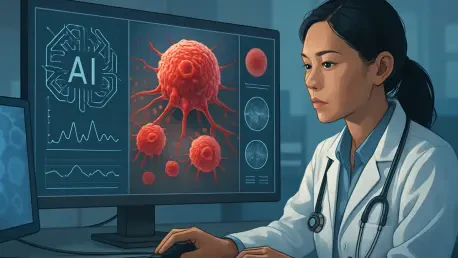In the ever-evolving landscape of cancer treatment, immunotherapies such as CAR T-cell therapy and T-cell engager therapies have emerged as revolutionary options, offering renewed hope to patients battling hematologic malignancies like lymphomas, leukemias, and multiple myeloma. However, these cutting-edge treatments carry a significant risk in the form of cytokine release syndrome (CRS), a potentially fatal condition triggered by an overwhelming release of cytokines into the bloodstream. Symptoms can range from mild discomfort, such as fever and nausea, to life-threatening complications like hypotension and organ failure. The challenge lies in detecting and managing CRS swiftly to prevent severe outcomes, a task that current healthcare practices struggle to achieve efficiently. As the demand for safer and more accessible cancer therapies grows, technology, particularly artificial intelligence (AI), is stepping in as a transformative force. This article delves into how AI-driven solutions paired with digital health tools can redefine CRS management, enhancing patient safety and broadening access to these life-saving treatments through innovative monitoring and timely interventions.
The Challenge of Cytokine Release Syndrome in Immunotherapy
Understanding CRS and Its Impact
The advent of immunotherapy has marked a pivotal shift in oncology, harnessing the power of the immune system, particularly T cells, to target and destroy cancer cells with unprecedented precision. Therapies like CAR T-cell and T-cell engager treatments have gained traction, with numerous approvals from the U.S. Food and Drug Administration, reflecting their critical role in managing complex blood cancers. Yet, the shadow of cytokine release syndrome looms large over these advancements. CRS occurs when activated immune cells release a flood of cytokines, leading to systemic inflammation that can escalate rapidly. Studies indicate an incidence rate ranging from 42% to 100% among patients undergoing CAR T-cell therapy, with severe cases—graded 3 or higher—affecting up to 46% of recipients. The spectrum of symptoms, from mild fever to catastrophic organ dysfunction, underscores the urgent need for robust strategies to monitor and mitigate this adverse effect before it becomes life-threatening.
Beyond the immediate health risks, CRS poses a broader challenge to the adoption of immunotherapy as a mainstream treatment option. The potential for rapid deterioration means that patients must be closely observed, often in specialized settings, which limits the scalability of these therapies. For many, especially those in rural or underserved regions, accessing centers equipped to handle such complications is a significant barrier. Moreover, the unpredictability of CRS onset and severity adds a layer of complexity for healthcare providers who must balance the benefits of immunotherapy against the risk of adverse events. This situation not only affects patient outcomes but also slows the integration of these therapies into wider clinical practice. Addressing CRS effectively is thus not just a medical necessity but a critical step toward democratizing access to innovative cancer treatments across diverse populations and geographies.
Limitations of Current Monitoring Practices
Traditional approaches to managing CRS rely heavily on inpatient monitoring, where patients remain in hospital settings for days or even weeks following immunotherapy infusion to ensure safety. This method involves episodic checks of vital signs and subjective assessments by healthcare professionals, often missing the subtle early indicators of CRS progression. While this close supervision is crucial for catching severe symptoms, it comes at a steep cost—both financially and logistically. Extended hospital stays drive up healthcare expenses, placing a significant burden on patients and systems alike. Additionally, the need for specialized facilities means that only a fraction of eligible patients, particularly those near urban centers with advanced oncology units, can access these treatments. This geographic disparity exacerbates inequalities in cancer care, leaving many without viable options despite the potential benefits of immunotherapy.
Furthermore, the reliance on inpatient care creates bottlenecks that hinder the broader application of immunotherapy in clinical settings and research. Prolonged hospitalizations strain hospital resources, limiting bed availability for other critical cases and contributing to overcrowding in facilities. For clinical trials, the requirement for extended in-person monitoring discourages patient participation, especially among those who cannot afford the time or travel associated with such commitments. This slows the pace of research and delays the development of new therapies that could address existing limitations. The subjective nature of current monitoring practices also introduces variability in how CRS is detected and managed, as decisions often depend on individual clinician judgment rather than standardized, objective data. These challenges highlight the pressing need for a more efficient, accessible, and precise approach to safeguard patients undergoing transformative cancer treatments.
AI and Digital Health: A New Frontier in CRS Management
Continuous Monitoring with Wearable Devices
Artificial Intelligence, coupled with digital health innovations, is poised to transform the landscape of CRS management by introducing continuous monitoring through wearable devices. These tools, worn by patients before and after immunotherapy, collect real-time physiological data such as heart rate, temperature, and blood pressure, creating a comprehensive baseline for each individual. AI algorithms then analyze this stream of information to detect anomalies that may signal the onset of CRS, often before visible symptoms emerge. This early warning system empowers healthcare providers to intervene promptly, administering treatments like corticosteroids or tocilizumab to halt the progression of the syndrome. By identifying subtle changes in vital signs, such as a slight increase in fever or a drop in blood pressure, this technology can significantly reduce the risk of severe outcomes, enhancing patient safety during a critical window of vulnerability post-infusion.
The impact of continuous monitoring extends beyond mere detection, offering a proactive framework that redefines patient care in oncology. Unlike traditional episodic checks, which may miss fleeting but critical changes, AI-driven systems provide a constant flow of data, ensuring no warning sign goes unnoticed. This capability is particularly vital for patients at higher risk of severe CRS, where even a short delay in response can lead to dire consequences. Real-world case studies have demonstrated the efficacy of this approach, with instances where early alerts enabled timely interventions that reversed symptoms and prevented escalation. Moreover, the integration of wearable devices allows for remote oversight, meaning healthcare teams can monitor patients from afar, reducing the need for constant physical presence in a hospital. This shift not only improves the precision of CRS management but also lays the groundwork for safer, more flexible treatment protocols that prioritize patient well-being and resource efficiency.
Broader Benefits to Patient Care and Research
The adoption of AI-driven monitoring in CRS management heralds significant advantages for patient care, particularly in facilitating a transition from inpatient to outpatient settings. By enabling real-time tracking of vital signs through digital platforms, this technology reduces the necessity for prolonged hospital stays, allowing many patients to recover in the comfort of their homes while still under close supervision. This change alleviates the financial and emotional burden of extended hospitalizations, making immunotherapy more accessible to a wider demographic, including those in remote areas far from specialized centers. The cost savings for healthcare systems are substantial as well, freeing up hospital beds and resources for other urgent needs. For patients, the ability to maintain a semblance of normalcy during treatment can improve overall mental health and quality of life, a factor often overlooked in the intensity of cancer care but crucial for long-term recovery.
In addition to enhancing individual care, AI and digital health tools offer transformative potential for clinical research and the development of new immunotherapies. Remote monitoring capabilities lower the barriers to patient recruitment in trials by eliminating the need for frequent in-person visits, thus encouraging participation from diverse geographic and socioeconomic backgrounds. This inclusivity accelerates the pace of research, enabling faster collection of data on treatment efficacy and safety. Furthermore, the continuous data gathered through wearable devices provides researchers with deeper insights into immune responses and CRS patterns, fostering the creation of more targeted and effective therapies. The ripple effect of these advancements could reshape the future of oncology, driving innovations that not only manage adverse effects like CRS more effectively but also refine the precision of cancer treatments as a whole. As these technologies mature, their role in bridging gaps between clinical practice and research becomes increasingly indispensable.
Shaping Future Standards in Cancer Care
Looking back, the integration of AI into CRS management marked a turning point in how oncology embraced technology to address critical challenges. The ability to monitor patients continuously through wearable devices and sophisticated algorithms redefined safety protocols, ensuring that early signs of cytokine release syndrome were caught and addressed with remarkable speed. This approach drastically cut down the incidence of severe outcomes, as timely interventions became the norm rather than the exception. Reflecting on the strides made, the shift to outpatient care stood out as a significant achievement, easing the strain on healthcare facilities while empowering patients with greater autonomy during their treatment journey. The data amassed from these initiatives also enriched clinical understanding, offering a clearer picture of immune dynamics that informed better therapeutic strategies.
As the field moved forward, the focus shifted to solidifying these gains through standardized practices and broader implementation. Establishing universal guidelines for AI-driven monitoring emerged as a key next step, ensuring consistency across diverse healthcare settings. Collaboration among medical professionals, technologists, and regulatory bodies became essential to validate and scale these solutions, addressing any lingering technical or logistical hurdles. Encouraging investment in digital health infrastructure promised to make such innovations accessible even in underserved regions, further narrowing disparities in cancer care. Ultimately, the journey of integrating AI into CRS management highlighted a path toward a future where technology and medicine converge seamlessly, delivering precision, safety, and equity in treating one of humanity’s most formidable diseases.









